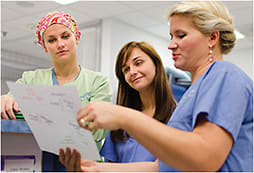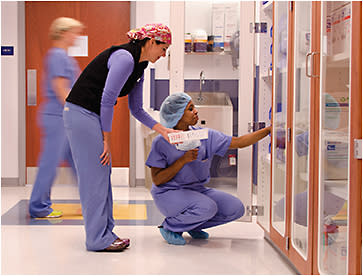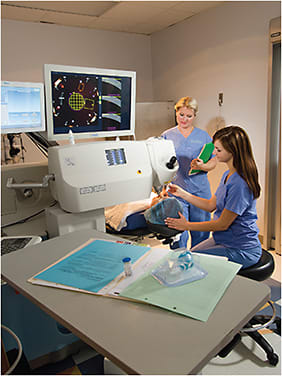Surgery
Crack the code on efficient staffing in the ASC
Here’s how Physicians’ Eye Surgical Center keeps the schedule flowing smoothly.
BY JENNIFER BLANTON, RN, CHARLESTON, S.C.

From left: Jenny Dorsey, RN; Chelsey Boston, RN; Joanna Jones, RN; and Patti Marnell, Insurance clerk, all contribute to ASC efficiency at Physicians’ Eye Surgical Center in Charleston, S.C. Photography by John Zillioux
We all know the contributions of dedicated surgical staff in the ASC are what keep our practices’ gears grinding. But the rate at which the team’s work is accomplished is based on appropriate scheduling. Without a surgical scheduling template, teams are lost. Without guidance, individual members will complete necessary tasks in a variety of orders, creating potential redundancies, inefficiencies or, at worst, errors. At Physicians’ Eye Surgical Center in Charleston, S.C., we have faced these challenges and cracked the code on surgical scheduling efficiency.
Here, we share the lessons we’ve learned and the techniques we’ve developed to keep things running smoothly.
Flexibility
Proper utilization of staff is an important aspect of efficiency in the ASC. Since every surgery center has a different case mix and patient volume, no exact staffing equation is possible. However, a typical staffing plan consists of one circulator, one scrub technician and one preoperative nurse for each scheduled OR. Post-anesthesia care units (PACUs) are scheduled based on the number of surgeons operating. For instance, if we have a plastic surgeon in OR one, a retina surgeon in OR two and a cataract surgeon alternating between OR’s three and four, I will staff three PACU nurses or two PACU nurses and one medical assistant depending on the case mix. The need for PACU nursing staff decreases depending on whether you are recovering cataract patients or retina and plastics patients. For example, our cataract patients receive minimal sedation and are ready for discharge after about 10-15 minutes of recovery. Oculoplastics and retina surgical patients can take longer to recover, especially if they are receiving general anesthesia. They may need 30-60 minutes for recovery time. The actual case time is also different, with the average cataract surgery taking 10-15 minutes and retina and plastics taking 30-50 minutes. This variability in surgical and recovery time changes the staffing needs for PACU.
Anticipate your surgeon
Scheduling templates are built around each individual surgeon’s cut times. For example, if a surgeon takes an average of 10 minutes from incision start to incision end, a template will be built for 15-minute blocks. This allows two and a half minutes for preparing a patient for surgery in the OR and two and a half minutes to get the next patient into the OR. The goal is to keep the surgeon moving and busy. Too long of a delay in between cases is wasted time. When a cataract surgeon is scheduled to alternate between two rooms, allow no time for delays. Have the patient draped and ready for the procedure the moment the surgeon leaves one OR and enters the next. If a cataract surgeon is in one OR, a yag laser is often scheduled in between cases so that the surgeon always has a place to go. With each scenario, communication within the team is vital. At our practice, we’ve created simple signs that direct the surgeon where to go next. They display directions such as “go to next OR,” “yag laser ready,” “femto laser ready” and “mark patients.” These simple signs placed on the table by the OR door serve as visual cues for staff, surgeon and anesthesia team.

Ashley Robinson, RN, Virginia Churchill, RN, and Jenny Blanton, RN, review paperwork.
Full-time employees are cross-trained to fill various roles when needed. Our preoperative nurses also work in PACU. Three of our nurses can also scrub. Seven out of the 10 full-time employees are cross-trained to circulate in the OR. This flexibility of the staff encourages teamwork and enables increased productivity and efficiency.
Preventing down time
We base our staffing needs on how many cases and types of cases we handle on any given day. For instance, if I review the schedule for the following week and find that more than half of the 50 cataracts posted are scheduled for femtosecond laser, I will staff an additional nurse and an additional scrub tech for the procedure room. This helps us keep patients moving in and out of the procedure room efficiently. The ultimate goal with staffing is to make sure that the surgeon is able to quickly move from one case to the next with no down time.
Most of my staff members understand that if they are in the building, they need to be working. The full-time staff members who require consistent hours spend down time with various assigned tasks, such as preoperative phone calls, postoperative follow-up calls, chart audits, preparing for upcoming cases, and restocking duties.
Have a process for every role
An efficient center is one that has a process in place for everything. At Physicians’ Eye Surgery Center, we have a process in place for each role including preoperative, intraoperative, and postoperative care.
Years ago, I watched the set up and turnover for cataract surgery performed by two circulators for one surgeon who typified surgical inefficiency. One circulator’s process was entirely inconsistent with the other circulator’s process. When a team has no rhyme or reason to the order in which tasks are completed, the loss of productivity and wasted time is starkly evident.

Laura Lempesis, RN (standing), and Shelah Durant, scrub tech (kneeling), pull materials for surgery.
Circulator steps
Make it your aim to have the patient prepped and draped for surgery. Every step taken should be prioritized to accomplish that goal. In the above case, changes were quickly made to require OR staff to follow the same process every time a patient was brought into the OR.
Our steps for circulators are as follows:
1. Bring patient into the OR (a bumper is taped on the floor that indicates where the stretcher should be placed each time).
2. Perform site verification with orders in hand and immediately document on whiteboard in OR the patient’s name, operative site, implant and allergies.
3. Position patient for surgery. Prep and drape patient for surgeon.
4. Assist scrub technician and complete any additional tasks.
These are actual step-by-step instructions that go over how to check a patient in, prepare a patient for surgery, room set up, room turnover, etc.
Check-in process
We’ve found that if the charts can be prepared as much as possible in advance, we can minimize check-in delays. We assign a specific staff member the daily responsibility to “prep” the next day’s charts. This process includes:
• Filling out the consents for surgery (name of patient, surgeon, operation, operative site, date).
• Filling out identification bracelets and listing allergies (front office staff perform first verification and attach bracelet upon arrival on operative side, right eye = right arm).
• Highlighting demographics information so patients can easily verify accuracy.
• Highlighting each form that needs signatures from the patient.
When the patient comes up to the desk, the check-in packet that has been clipped together in the chart with the ID bracelet attached is pulled and check-in is expedited. All that remains is to copy insurance cards and collect fees.
Preoperative process
Patients are instructed to arrive 40-60 minutes prior to surgery to allow for check-in and the preoperative process. We complete the check-in and preoperative process in this order to ensure patient readiness for surgery:
• Greet patient. SMILE!! (Yes, that is written on our protocol)
• Introduction: “Hi, welcome to Physicians’ Eye Surgery Center. My name is____and I will be the nurse who will get you prepared for surgery.”
• Escort patient to stretcher chair (patients are placed on mobile chair that is used for the entire duration until discharge).
• Identify patient: “For safety reasons, let’s clarify who you are: Please tell me your full name and date of birth (check bracelet). Ask, “which eye are we working on today?”
• Immediately after verification, instill dilation drops (drops are instilled as the first step after verification since lack of dilation can delay the case. The sooner they are instilled, the longer they have to work).
• Obtain vital signs, complete admission assessment, and start IV.
• Bring family member back and review postoperative instructions with patient and family member. (Completing discharge instructions preoperatively allows for decreased PACU time).

Jenny Blanton, RN, and Virginia Churchill, RN, prepare a patient for surgery.
Room set up and turnover
Again, advance preparation allows for increased efficiencies on day of surgery. Staff prepare by pulling all lenses and case procedure packs two to three days in advance. These are then pulled into the OR on the morning of surgery where they are easily accessible. Surgeon preference cards are pulled in advance and any potential “extras” that will be needed for that particular surgeon are put in a separate kit in the OR. Having extra equipment already pulled and in the room saves time during the case. For turnover, the circulator instills postoperative drops and removes the drape. If utilizing one OR, the anesthesiologist will take the patient to recovery and the circulator will take the trash out of the OR on the way to get the next patient. The scrub then wipes down the room and begins opening the next case. When a surgeon is alternating between two ORs, this process changes slightly with the circulator taking the patient out of the OR and the anesthesiologist following the surgeon to the next room. Having everything at your fingertips really does speed things up. We even pull out and separate the number of trash bags we will need for the day and hang them over the receptacle for easier accessibility.
Consistency
Having a consistent process in place in each area allows for any staff member to enter into a room and determine where another staff member is at in the process and assist if necessary. Each process is evaluated annually to see if improvements can be made. It is an effective way to find out where and why delays occur.
With three-and-a-half minute turnover times and less than two hours for total patient time at the center, we are extremely proud of the team we have assembled. Our surgeons are happy to work in an environment with highly trained and efficient staff and our patients rave about their great experience at our center. OP

|
Jennifer Blanton, RN, is director of nursing at Physicians’ Eye Surgery Center in Charleston, S.C., an ophthalmology-only center that performs approximately 8,000 cases in four ORs annually. |








